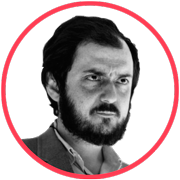Expertise: Stanley Kubrick’s Photography

When Kubrick was in high school he was chosen to be an official school photographer. In 1946, he began attending evening classes at the City College of New York, but then left school. Eventually he got a freelance job at Look magazine, and became their staff photographer.
Kubrick was well known for his ability to tell a story in just a few photographs. On April 16, 1946 his photo series “A Short Short From a Balcony Movie” was published. It was a story about a young man who gets rejected after making advances on the young woman sitting beside him. The subjects were Kubrick’s friends, but they had no idea about the general scenario – each of them knew only their own parts. The man had to kiss the woman, and the woman had to slap him in the face.
{ “img”: “/wp-content/uploads/2014/11/artist-ny.jpg”, “alt”: “Expertise: Stanley Kubrick’s Photography”, “text”: “From the series New York: World Art Center” },
{ “img”: “/wp-content/uploads/2014/11/artist-ny-2.jpg”, “alt”: “Expertise: Stanley Kubrick’s Photography”, “text”: “From the series New York: World Art Center” },
{ “img”: “/wp-content/uploads/2014/11/boxing0.jpg”, “alt”: “Expertise: Stanley Kubrick’s Photography”, “text”: “From the series Prizefighter” },
{ “img”: “/wp-content/uploads/2014/11/boxing.jpg”, “alt”: “Expertise: Stanley Kubrick’s Photography”, “text”: “From the series Prizefighter” },
{ “img”: “/wp-content/uploads/2014/11/boxing2.jpg”, “alt”: “Expertise: Stanley Kubrick’s Photography”, “text”: “From the series Prizefighter” },
{ “img”: “/wp-content/uploads/2014/11/boxing3.jpg”, “alt”: “Expertise: Stanley Kubrick’s Photography”, “text”: “From the series Prizefighter” }
Kubrick’s photo essay “New York: World Art Center” was published in 1948. After seeing one of the photographs featuring German anti-fascist artist George Grosz, Mike Cowles, one of Look‘s publishers told him, “I think you just took the picture of the year… George Grosz parked on a chair in the middle of Fifth Avenue (with a NO PARKING sign alongside) is IT!”
While working for the Look magazine, Kubrick completed more than 300 assignments and took over 27,000 photographs. Being a fan of boxing, he also did several photo series about hit-fests. His “Prizefighter” series featured Walter Cartier and Rocky Graziano. In 1951, Kubrick completed his debut short movie Day of the Fight starring Cartier.

If you saw the photography of Larry Clark you would instantly know that it was by him as the style and the subject matter in his photography is very similar to his oeuvre of films such as Kids and Ken Park. He focuses on teenagers with a Nan Goldin sensibility.
However, if you were shown the early photography of Stanley Kubrick you might be scratching your head as to which film director took the images. Possibly, you might think of Alfred Hitchcock or maybe even Martin Scorsese. Before seeing Kubrick’s work I would have expected the frames to be filled with a psychotic menace, symmetrical, and with vacant eyed twins staring out at you for example. Having said that and thought about it for a moment or two, his earlier films such as Fear and Desire and Spartacus aren’t particularly menacing that perilous sentiment seemed to evolve later on in his career.
{ “img”: “/wp-content/uploads/2014/11/kubric.jpg”, “alt”: “Expertise: Stanley Kubrick’s Photography”, “text”: “Stanley Kubrick for Look Magazine” },
{ “img”: “/wp-content/uploads/2014/11/stanley_kubrick.jpg”, “alt”: “Expertise: Stanley Kubrick’s Photography”, “text”: “Stanley Kubrick for Look Magazine” },
{ “img”: “/wp-content/uploads/2014/11/kubrick3.jpg”, “alt”: “Expertise: Stanley Kubrick’s Photography”, “text”: “Stanley Kubrick for Look Magazine” },
{ “img”: “/wp-content/uploads/2014/11/kubrick4.jpg”, “alt”: “Expertise: Stanley Kubrick’s Photography”, “text”: “Stanley Kubrick for Look Magazine” },
{ “img”: “/wp-content/uploads/2014/11/kubrick5.jpg”, “alt”: “Expertise: Stanley Kubrick’s Photography”, “text”: “Stanley Kubrick for Look Magazine” },
{ “img”: “/wp-content/uploads/2014/11/kubrick7.jpg”, “alt”: “Expertise: Stanley Kubrick’s Photography”, “text”: “Stanley Kubrick for Look Magazine” }
If one day you managed to find the food blender that had been tucked away in your kitchen cupboard for the last eight years and you put Cartier-Bresson and Diane Arbus in it you might end up with Kubrick the image maker. The images I have looked at are all black and white, square format and depicting life in New York in the 1940s. Arbus was criticized for not actually liking people very much, however; you couldn’t say that of Kubrick. He seems to have a fondness for his subjects and is interested in presenting them at their best. Unlike William Klein and Henry Cartier-Bresson who went out in the streets and either waited with their cameras for the right subject to enter their carefully contrived compositions or stopped a kid and said “point your gun at me,” Stanley Kubrick seems to be directing people even with his still work. There is a slight illusion of candidness but I suspect they were all carefully controlled and managed. This is where there is a calling card to his later film work as he was notoriously meticulous about every scene and would shoot and shoot until it was exactly as he wanted. Some may label him as a control freak because of this, whereas I like to think of it as a pursuit of excellence or perfection.
And there is a perfection to his photography. The compositions always hit the bullseye. He obviously is immersed in all the rules such as the rule of thirds and how to play with light and both utilizes the rule book and deconstructs it with great aplomb. There is a lightness and joy to the images as well as a filmic quality, one of the shots is Raging Bull meets Bugsy Malone for example. This is work I could definitely spend a long, long time looking at.
New and best




